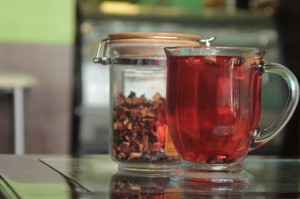 Your teapot is a beautiful and efficient way to brew a tasty cup of tea. Brewing in a ceramic, glass, or cast iron teapot has the advantage of eliminating the “pot” flavor that can result from brewing in a stainless or aluminum container.
Your teapot is a beautiful and efficient way to brew a tasty cup of tea. Brewing in a ceramic, glass, or cast iron teapot has the advantage of eliminating the “pot” flavor that can result from brewing in a stainless or aluminum container.
Porcelain, ceramic and glass teapots are preferred by the English and others, while cast iron teapots are popular in Japan because of their heat retaining properties. The tiny tea pots and cups found in Asian markets are used for brewing and enjoying Oolong Tea. Whatever kind of teapot you choose, the steps to a perfect cup of tea are the same.
Start with fresh, cold water. While it may seem more efficient to begin with hot water, hoT water has lost many of its gases and will leave the tea tasting flat. Fill an empty kettle with cold running water and bring to a rolling boil.
Pre-heat the teapot by filling it with hot water. Pre-heating the teapot will keep the water hot longer and yield a better brew.
As the water approaches the proper temperature for brewing your tea, empty the teapot and add the appropriate measure of tea leaves for your size pot. It is customary to use a teaspoonful of tea per cup of tea, plus “one for the pot”.
You may use tea bags, or loose tea. When using loose tea, most people employ a strainer or tea ball to keep the leaves out of their cup. But, doing so means there will be no tea leaves to “read” later.
Do not allow the water in the kettle to boil for long as gases will be lost. Use the water as it just reaches the boiling stage. Add the hot water, boiling or just under boiling depending on the tea you are brewing, to the teapot. Allow the tea to infuse for the recommended time, depending on the kind of tea you are brewing, usually 3 to 5 minutes.
Do not over brew. Leaving the tea to brew too long will result in a bitter tea. Instead, if you prefer strong tea, add more tea. Or, if you prefer a second cup, prepare a second brewing.
During brewing, swirl, shake, or stir the pot once or twice to blend and circulate the infusion. Let the leaves settle before pouring.
If your teapot has a built in strainer of sufficient quality, you can pour the tea directly into the cup. If not, you may prefer to pour through a strainer, unless you are using a tea ball. If you are using a fine quality cup that might break with the sudden addition of very hot tea, you might prefer to warm the cup before pouring. I have never done this, but my china is not of the thin porcelain or antique that might be at risk.
When the tea has brewed the required time and is ready to pour, you should pour all the tea immediately. Do not allow the tea to continue to steep, as it will get bitter. If you have prepared enough for a second cup, pour the tea into a separate heated pot. When using tea bags, remove the tea bags from the teapot and squeeze them gently to extract all the tea flavor.
If you prefer a stronger tea, you should add more tea rather than steeping longer. You cannot judge the strength of the tea by its color, as many teas are pale in color when properly brewed. You now have a perfect cup of tea, ready for drinking. You can add milk, sugar, honey, lemon, or whatever flavorings you prefer now and enjoy.
For more information on brewing tea and the different types of tea, visit All About Tea [http://tea.easysoutherncooking.com]. Diane Watkins is an educator and cook. She writes about food and cooking at Easy Southern Cooking [http://easysoutherncooking.com].
Article Source: http://EzineArticles.com/?expert=Diane_Watkins

Speak Your Mind
You must be logged in to post a comment.